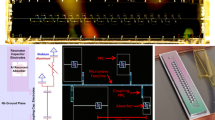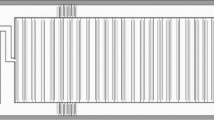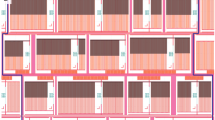Abstract
The Balloon Experiment for Galactic INfrared Science (BEGINS) is a concept for a sub-orbital observatory that will operate from \(\lambda\) = 25 to 250 \(\upmu\)m to characterize dust in the vicinity of high-mass stars. The mission’s sensitivity requirements will be met by utilizing arrays of 1840 lens-coupled, lumped-element kinetic inductance detectors (KIDs) operating at 300 mK. Each KID will consist of a titanium nitride (TiN) parallel strip absorbing inductive section and parallel plate capacitor deposited on a Silicon (Si) substrate. The parallel plate capacitor geometry allows for reduction of the pixel spacing. At the BEGINS focal plane, the detectors require optical NEPs from \(2\times 10^{-16}\) to \(6\times 10^{-17}\) W/\(\sqrt{\text {Hz}}\) from 25 to 250 \(\upmu\)m for optical loads ranging from 4 to 10 pW. We present the design, optical performance and quasiparticle lifetime measurements of a prototype BEGINS KID array at 25 \(\upmu\)m when coupled to Fresnel zone plate lenses. For our optical set up and the absorption efficiency of the KIDs, the electrical NEP requirement at 25 \(\upmu\)m is \(7.6\times 10^{-17}\) W/\(\sqrt{\text {Hz}}\) for an absorbed optical power of 0.36 pW. We find that over an average of five resonators the the detectors are photon noise limited down to about 200 fW, with a limiting NEP of about \(7.4\times 10^{-17}\) W/\(\sqrt{\text {Hz}}\). Future arrays will be coupled to microlens arrays and have higher optical efficiencies.





Similar content being viewed by others
Notes
Plots of fits to the data can be found in Joanna Perido’s dissertation, Kinetic Inductance Detectors and Metal-Mesh Filters for Far-Infrared Astronomy Section 5.2.2 [13].
The KID inductor absorption efficiency was electromagnetically simulated using ANSYS High Frequency Structure Simulator (https://www.ansys.com/products/electronics/ansys-hfss).
References
N.F. Cothard, Parallel plate capacitor aluminum kids for future far-infrared space-based observatories. J. Low Temp. Phys. (2023). https://doi.org/10.1007/s10909-023-03039-0
N.F. Cothard et al., Monolithic silicon microlens arrays for far-infrared astrophysics. Appl. Opt. 63, 1481 (2023)
P. Diener, H.G. Leduc, S.J.C. Yates, Y.J.Y. Lankwarden, J.J.A. Baselmans, Design and testing of kinetic inductance detectors made of titanium nitride. J. Low Temp. Phys. 167, 305–310 (2012)
J. Gao, The Physics of Superconducting Microwave Resonators. Diss. (California Institute of Technology, 2008)
J. Gao, M. Daal, J.M. Martinis, A. Vayonakis, J. Zmuidzinas, B. Sadoulet, B.A. Mazin, P.K. Day, H.G. Leduc, A semiempirical model for two-level system noise in superconducting microresonators. Appl. Phys. Lett. 92(21), 212504 (2008)
J. Hubmayr, J. Beall, D. Becker, H.M. Cho, M. Devlin, B. Dober, C. Groppi et al., Photon-noise limited sensitivity in titanium nitride kinetic inductance detectors. Appl. Phys. Lett. 106(7), 073505 (2015)
S. Kumar, Submillimeter Wave Camera Using a Novel Photon Detector Technology. Diss. (California Institute of Technology, 2008)
H.G. Leduc, B. Bumble, P.K. Day, B.H. Eom, J. Gao, S. Golwala, B.A. Mazin et al., Titanium nitride films for ultrasensitive microresonator detectors. Appl. Phys. Lett. 97(10), 102509 (2010)
O. Noroozian et al., Two-level system noise reduction for microwave kinetic inductance detectors. AIP Conf. Proc. (2009). https://doi.org/10.1063/1.3292302
O. Noroozian, Superconducting Microwave Resonator Arrays for Submillimeter/far-infrared Imaging. Diss (California Institute of Technology, 2012)
Z. Pan, K.R. Dibert, J. Zhang, P.S. Barry, A.J. Anderson, A.N. Bender, B.A. Benson et al., Noise optimization for MKIDs with different design geometries and material selections. IEEE Trans. Appl. Supercond. 33(5), 1–8 (2023)
J. Perido, J. Glenn, P. Day, A. Fyhrie, H. Leduc, J. Zmuidzinas, C. McKenney, Extending KIDs to the mid-IR for future space and suborbital observatories. J. Low Temp. Phys. 199(3–4), 696–703 (2020)
J. Perido, Kinetic Inductance Detectors and Metal-Mesh Filters for Far-Infrared Astronomy. Diss. (University of Colorado at Boulder, 2023)
J. Wheeler, Millimeter-Wave Galaxy Spectroscopy: SuperSpec On-Chip Spectrometer Technology Development and ALMA Observations of Molecular Gas in the Arp 220 Nucleus (University of Colorado at Boulder, Diss, 2019)
J.C. Wiltse, The Fresnel zone-plate lens. Millimeter Wave Technol. III 544, 41–47 (1985)
J. Zmuidzinas, Superconducting microresonators: physics and applications. Annu. Rev. Condens. Matter Phys. 3(1), 169–214 (2012)
Acknowledgements
Portions of this research were carried out at the Jet Propulsion Laboratory, California 214 Institute of Technology, under a contract with NASA (80NM0018D0004). This work was also supported by internal grants at NASA GSFC. Joanna Perido was supported by the NASA Future Investigators in NASA Earth and Space Science. Nicholas F. Cothard was supported by the NASA Postdoctoral Program Fellowship at NASA GSFC.
Author information
Authors and Affiliations
Contributions
Joanna Perido wrote the main manuscript. Peter Day and Nicholas Cothard reviewed the manuscript. Measurements were performed by Joanna Perido and Byeoung H. Eom. Figure 1 was provided by Peter Day and Henry Leduc. Figures 2–5 were prepared by Joanna Perido. Jason Glenn was the lead PI. Device was fabricated by Henry Leduc and Andrew B. Steven Hailey-Dunsheath helped with derivation of Eq. 3.
Corresponding author
Ethics declarations
Conflict of interest
The authors declare no Conflict of interest.
Additional information
Publisher's Note
Springer Nature remains neutral with regard to jurisdictional claims in published maps and institutional affiliations.
Rights and permissions
Springer Nature or its licensor (e.g. a society or other partner) holds exclusive rights to this article under a publishing agreement with the author(s) or other rightsholder(s); author self-archiving of the accepted manuscript version of this article is solely governed by the terms of such publishing agreement and applicable law.
About this article
Cite this article
Perido, J., Day, P.K., Beyer, A.D. et al. Parallel-Plate Capacitor Titanium Nitride Kinetic Inductance Detectors for Infrared Astronomy. J Low Temp Phys (2024). https://doi.org/10.1007/s10909-024-03101-5
Received:
Accepted:
Published:
DOI: https://doi.org/10.1007/s10909-024-03101-5




